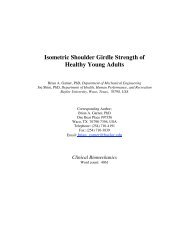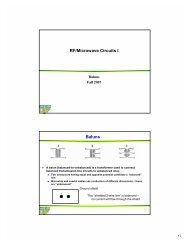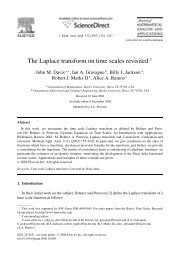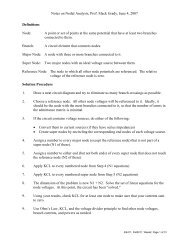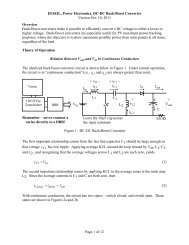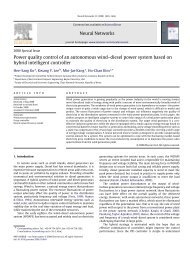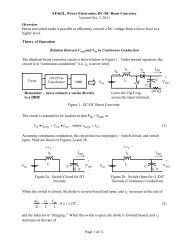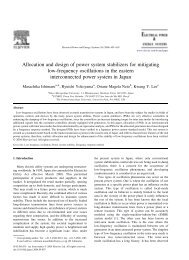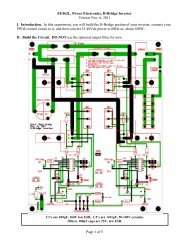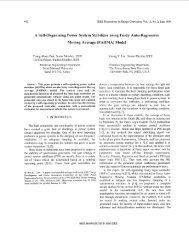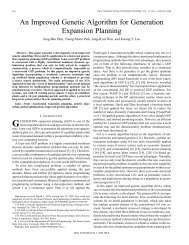An Evaluation of Feature Extraction Methods for Vehicle ... - ECS
An Evaluation of Feature Extraction Methods for Vehicle ... - ECS
An Evaluation of Feature Extraction Methods for Vehicle ... - ECS
Create successful ePaper yourself
Turn your PDF publications into a flip-book with our unique Google optimized e-Paper software.
<strong>An</strong> <strong>Evaluation</strong> <strong>of</strong> <strong>Feature</strong> <strong>Extraction</strong> <strong>Methods</strong> <strong>for</strong> <strong>Vehicle</strong><br />
Classification Based On Acoustic Signals<br />
Ahmad Aljaafreh, Student Member, IEEE and Liang Dong, Senior Member, IEEE<br />
Abstract— Classification <strong>of</strong> ground vehicles based on acoustic<br />
signals can be employed effectively in battlefield surveillance,<br />
traffic control, and many other applications. The classification<br />
per<strong>for</strong>mance depends on the selection <strong>of</strong> signal features that<br />
determine the separation <strong>of</strong> different signal classes. In this paper,<br />
we investigate two feature extraction methods <strong>for</strong> acoustic<br />
signals from moving ground vehicles. The first one is based on<br />
spectrum distribution and the second one on wavelet packet<br />
trans<strong>for</strong>m. These two methods are evaluated using metrics<br />
such as separability ratio and the correct classification rate.<br />
The correct classification rate not only depends on the feature<br />
extraction method but also on the type <strong>of</strong> the classifier. This<br />
drives us to evaluate the per<strong>for</strong>mance <strong>of</strong> different classifiers,<br />
such K-nearest neighbor algorithm (KNN), and support vector<br />
machine (SVM). It is found that, <strong>for</strong> vehicle sound data, a<br />
discrete spectrum based feature extraction method outper<strong>for</strong>ms<br />
wavelet packet trans<strong>for</strong>m method. Experimental results verify<br />
that support vector machine is an efficient classifier <strong>for</strong> vehicles<br />
using acoustic signals.<br />
I. INTRODUCTION<br />
DUE to the rapid progress in communications and sensor<br />
technologies, wireless sensor networks become very<br />
attractive area <strong>of</strong> research . It has been implemented in many<br />
disciplines and fields. There are uncountable applications <strong>for</strong><br />
wireless sensor network. Data aggregation, event detection,<br />
monitoring, and tracking are some <strong>of</strong> the main applications<br />
<strong>for</strong> wireless sensor networks. Some <strong>of</strong> these applications<br />
deals with continuous signals, like sounds, images, videos,<br />
vibrations, magnetic field. Such applications need signal<br />
processing. Signal processing in wireless sensor network is<br />
mainly divided into the following categories: detection, classification,<br />
localization, and tracking. In this research we will<br />
investigate vehicle classification in wireless sensor network<br />
using acoustic signals. Moving ground vehicles affect the<br />
environment in different ways. <strong>Vehicle</strong> emits heats, sounds,<br />
magnetic field. There are many approaches that investigated<br />
vehicle identification based on different kinds <strong>of</strong> signals.<br />
The most promising approach <strong>for</strong> vehicle identification is<br />
the one that is based on acoustic signals. Moving vehicles<br />
emit characteristic sounds. These sounds are generated<br />
from moving parts, frictions, winds, emissions, tires,...etc.<br />
Assuming that similar vehicles that have the same working<br />
conditions generate the same sounds then these sounds can be<br />
used to classify vehicles [1]. This motivates people to study<br />
This work was supported in part by the DENSO North America Foundation<br />
and by the Faculty Research and Creative Activities Award <strong>of</strong> Western<br />
Michigan University.<br />
A. Aljaafreh and L. Dong are with the Department <strong>of</strong> Electrical and<br />
Computer Engineering, Western Michigan University, Kalamazoo, MI 49008<br />
USA (e-mail: ahmad.f.aljaafreh@wmich.edu, liang.dong@wmich.edu).<br />
how to extract the best features that characterize each class<br />
<strong>of</strong> vehicles. <strong>Vehicle</strong> classification has been investigated in<br />
different domains, time domain, frequency domain, and timefrequency<br />
domain. The problem is how to extract the best<br />
features <strong>of</strong> the vehicle sound that characterize each vehicle<br />
type. Classification in this paper is based on frequency and<br />
time-frequency domain analysis. First we use the overall<br />
spectrum distribution to extract features, Since we assume<br />
that time dimension in this application has little in<strong>for</strong>mation.<br />
Most <strong>of</strong> the in<strong>for</strong>mation <strong>of</strong> vehicle sound is represented by<br />
spectrum distribution [2]. Sounds <strong>of</strong> vehicle that change with<br />
time are not characteristic features <strong>of</strong> vehicle. For instance<br />
if we have a stationary object with a fixed sound this sound<br />
will be characterized by the spectrum distribution. If we start<br />
moving this object the spectrum will be effected because<br />
<strong>of</strong> Doppler effect, noise and interference which none <strong>of</strong><br />
them can be considered as a feature in our case. Because<br />
all <strong>of</strong> them do not depend on the vehicle but depend on<br />
the environment and on other none stationary variables that<br />
can not be considered as features like vehicle speed. This<br />
motivates us to think <strong>of</strong> a way to extract a good feature<br />
from the overall spectrum distribution <strong>of</strong> a moving ground<br />
vehicles. It is highly unlikely to identify moving ground<br />
vehicles in wireless sensor network vehicles if the features<br />
depend on some frequency components [2]. This is because,<br />
low frequency components exist <strong>for</strong> most <strong>of</strong> ground moving<br />
vehicle types. Frequency components magnitudes are not<br />
considered as good features because <strong>of</strong> the none station<br />
power distribution <strong>of</strong> the vehicle sounds. The power <strong>of</strong> the<br />
received signal depends mainly on the distance between<br />
vehicle and sensor and on the weather conditions, also it<br />
depends on the speed <strong>of</strong> the vehicles and the noise power<br />
and many other variables. This makes it difficult to pick some<br />
frequency components and consider them as features. Thus it<br />
is better to extract the features based on the overall spectrum<br />
distribution. Assuming that each sound source <strong>of</strong> the vehicle<br />
acoustic signal has only a dominating band <strong>of</strong> frequency this<br />
makes vehicle sounds have quasi-periodic structure. These<br />
bands may vary because <strong>of</strong> vehicle motion but the general<br />
disposition remains the same. Based on this assumption we<br />
assume that each class <strong>of</strong> vehicles have a unique combination<br />
<strong>of</strong> energies in the blocks <strong>of</strong> wavelet packet trans<strong>for</strong>m as<br />
in [3], [4]. This paper proposes a feature extraction technique<br />
based on wavelet packet trans<strong>for</strong>m and it compares the<br />
results with the other technique that is based on the overall<br />
spectrum distribution using two metrics, Separability ratio<br />
and classification rate. Support vector machine is used as<br />
978-1-4244-6452-4/10/$26.00 ©2010 IEEE<br />
570
normaizled amplitude<br />
normalized amplitude<br />
5 x 1012 v1<br />
0<br />
−5<br />
0 5000<br />
time<br />
5 x v2 10−7<br />
0<br />
−5<br />
0 5000<br />
time<br />
normalized amplitude<br />
normaizled amplitude<br />
2 x 1012 v1<br />
1<br />
0<br />
−1<br />
0 5000<br />
time<br />
1 x v2 10−6<br />
0.5<br />
0<br />
−0.5<br />
−1<br />
0 5000<br />
time<br />
normalized amplitude<br />
normaizled amplitude<br />
2<br />
0<br />
−2<br />
4 x 1011 v1<br />
−4<br />
0 5000<br />
time<br />
1 x v2 10−6<br />
0.5<br />
0<br />
−0.5<br />
−1<br />
0 5000<br />
time<br />
normalized freq. mag.<br />
normalized freq. mag.<br />
0.1<br />
0.08<br />
0.06<br />
0.04<br />
0.02<br />
vehicle 1<br />
normalized freq. mag.<br />
0<br />
0 50 100<br />
frequency*Fs/(2*Fw)<br />
vehicle 2<br />
0.08<br />
0.06<br />
0.04<br />
0.02<br />
normalized freq. mag.<br />
0<br />
0 50 100<br />
frequency*Fs/(2*Fw)<br />
0.1<br />
0.08<br />
0.06<br />
0.04<br />
0.02<br />
vehicle 1<br />
normalized freq. mag.<br />
0<br />
0 50 100<br />
frequency*Fs/(2*Fw)<br />
vehicle 2<br />
0.2<br />
0.15<br />
0.1<br />
0.05<br />
normalized freq. mag.<br />
0<br />
0 50 100<br />
frequency*Fs/(2*Fw)<br />
0.1<br />
0.08<br />
0.06<br />
0.04<br />
0.02<br />
vehicle 1<br />
0<br />
0 50 100<br />
frequency*Fs/(2*Fw)<br />
vehicle 2<br />
0.2<br />
0.15<br />
0.1<br />
0.05<br />
0<br />
0 50 100<br />
frequency*Fs/(2*Fw)<br />
Fig. 1. Time domain <strong>for</strong> vehicle one in first row <strong>for</strong> three different sounds<br />
and <strong>for</strong> vehicle 2 in the second row.<br />
a classifier to find experimentally the classification rate.<br />
Then support vector machine classifier is compared with<br />
KNN classifier. The remainder <strong>of</strong> the paper is organized<br />
as follows. Section II presents the related work. Section III<br />
discusses the feature extraction methods. Section IV presents<br />
<strong>Feature</strong> <strong>Extraction</strong> Per<strong>for</strong>mance. Section V describes the<br />
experimental results. <strong>An</strong>d finally, conclusions are discussed<br />
in section VI.<br />
II. RELATED WORK<br />
Acoustic based vehicle classification differs mainly in<br />
feature extraction approaches. In [5] Fast Fourier Trans<strong>for</strong>m<br />
(FFT) and Power Spectral Density (PSD) are used to to<br />
extract feature vectors. Similarly in [6] the first 100 <strong>of</strong><br />
512 FFT coefficients are averaged by pairs to get a 50-<br />
dimensional FFT-based feature vector with resolution <strong>of</strong><br />
19.375 Hz and in<strong>for</strong>mation <strong>for</strong> frequencies up to 968.75<br />
Hz. Short Time Fourier Trans<strong>for</strong>m (STFT) is used in [7]<br />
to trans<strong>for</strong>m the overlapped acoustic Hamming windowed<br />
frames to a feature vector. Ref. [1] presents schemes to<br />
generate low dimension feature vectors based on PSD, using<br />
an approach that selects the most common frequency bands<br />
<strong>of</strong> PSD in all the training sets <strong>for</strong> each class. Ref. [2]<br />
proposes an algorithm that uses the overall shape <strong>of</strong> the<br />
frequency spectrum to extract the feature vector <strong>of</strong> each<br />
class. Principal component eigenvectors <strong>of</strong> the covariance<br />
matrix <strong>of</strong> the zero-mean-adjusted samples <strong>of</strong> spectrum are<br />
also used to extract the sound signature as in [8]. Ref. [9]<br />
proposes a probabilistic classifier that is trained on the<br />
principal components subspace <strong>of</strong> the short-time Fourier<br />
trans<strong>for</strong>m <strong>of</strong> the acoustic signature. Wavelet preprocessing<br />
provides multi-time-frequency resolution. Discrete Wavelet<br />
Trans<strong>for</strong>m (DWT) is used in [10] and [11] to extract features<br />
using statistical parameters and energy content <strong>of</strong> the wavelet<br />
coefficients. Wavelet packet trans<strong>for</strong>m is also used to extract<br />
vehicle acoustic signatures by obtaining the distribution <strong>of</strong><br />
the energies among blocks <strong>of</strong> wavelet packet coefficients like<br />
in [3] and [4].<br />
Fig. 2. Frequency distribution <strong>for</strong> vehicle one in first row <strong>for</strong> three different<br />
sounds and <strong>for</strong> vehicle 2 in the second row. Fs is sampling frequency =4960.<br />
Fw is FFT window size=512.<br />
III. FEATURE EXTRACTION OF THE GROUND MOVING<br />
VEHICLE’S SOUND<br />
A. <strong>Feature</strong> <strong>Extraction</strong> using the PSD <strong>of</strong> the STFT<br />
The goal is to develop a scheme <strong>for</strong> extracting a low<br />
dimension feature vector, which is able to produce good<br />
classification results. The first feature extraction technique <strong>of</strong><br />
acoustic signals in this paper is based on the low frequency<br />
band <strong>of</strong> the overall spectrum distribution. The low frequency<br />
band is utilized, because most <strong>of</strong> the vehicle’s sounds come<br />
from the rotating parts, which rotate and reciprocate in a<br />
low frequency, mainly less than 600 Hz. Sounds <strong>of</strong> moving<br />
ground vehicles are recorded at the nodes at a rate <strong>of</strong> 4960<br />
Hz. After the positive detection decision, a signal <strong>of</strong> event is<br />
preprocessed as the following:<br />
1) time preprocessing: DC bias should be removed by<br />
subtracting the mean from the time series samples.<br />
x i (n) =x i (n) − 1 N<br />
N ∗ ∑<br />
x i (n) (1)<br />
n=1<br />
.<br />
2) spectrum analysis: <strong>Feature</strong> vector will be the median<br />
<strong>of</strong> the magnitude <strong>of</strong> the STFT <strong>of</strong> a signal <strong>of</strong> event. It will be<br />
computed as the following: the magnitude <strong>of</strong> the spectrum<br />
is computed by FFT <strong>for</strong> a hamming window <strong>of</strong> size 512,<br />
without overlapping.<br />
X i (W )=FFT(x i (n)) (2)<br />
After this, the spectrum magnitude is normalized <strong>for</strong> every<br />
frame<br />
X i (W )<br />
X i (W )= ∑ K<br />
W =1 X (3)<br />
i(W )<br />
where K is the window size. The median <strong>of</strong> all frames is<br />
considered as the extracted feature vector.<br />
X if (W )=median(X i (W )) (4)<br />
571
0.16<br />
0.14<br />
v1<br />
mean<br />
standard deviation<br />
0.14<br />
0.12<br />
v2<br />
mean<br />
standard deviation<br />
1<br />
0.95<br />
SVM<br />
KNN<br />
0.12<br />
0.1<br />
0.9<br />
Spectrum Power<br />
0.1<br />
0.08<br />
0.06<br />
0.04<br />
Spectrum Power<br />
0.08<br />
0.06<br />
0.04<br />
Classification rate<br />
0.85<br />
0.8<br />
0.75<br />
0.02<br />
0.02<br />
0.7<br />
0<br />
0<br />
0.65<br />
−0.02<br />
0 500 1000<br />
ferquency(HZ)<br />
−0.02<br />
0 500 1000<br />
ferquency(HZ)<br />
6 7 8 9 10 11 12<br />
Wavelet Level<br />
Fig. 3. Acoustic spectra distribution <strong>of</strong> vehicle 1 and vehicle 2. To the left<br />
is vehicle 1<br />
Fig. 4. Classification rate vs. number <strong>of</strong> level <strong>for</strong> Wavelet Packet Trans<strong>for</strong>m.<br />
Where the training set is equal three and k <strong>for</strong> KNN=3.<br />
The mean <strong>of</strong> all frames could also be considered as the<br />
extracted feature vector.<br />
X if (W )= 1 Z<br />
Z∑<br />
X i (W ) (5)<br />
i=1<br />
where z = N/k. The first 64 points <strong>of</strong> the median <strong>of</strong> the<br />
spectrum magnitude contain up to 620 Hz. This gives a 64<br />
dimensional vector that characterizes each vehicle sound. We<br />
compared feature extraction using the mean and the median.<br />
The median gives better results, specially <strong>for</strong> noisy environments.<br />
Fig.3 displays the acoustic spectra distribution <strong>of</strong><br />
vehicle 1 and vehicle 2. For the Unknown utterance, the same<br />
steps are done, except one frame <strong>of</strong> FFT is considered as the<br />
feature to be classified to reduce the cost <strong>of</strong> computation,<br />
because this FFT computation is per<strong>for</strong>med online. This can<br />
be extended to have multiple frames, but this will increase<br />
the cost <strong>of</strong> computation.<br />
B. <strong>Feature</strong> Selection Using Wavlet Trans<strong>for</strong>m<br />
Wavelet trans<strong>for</strong>ms provide multi-resolution timefrequency<br />
analysis [12]. DWT approximation coefficients y<br />
are calculated by passing the time series samples x through<br />
a low pass filter with impulse response g.<br />
∑<br />
y(n) =x(n) ∗ g(n) =<br />
∞ x(k)g(n − k).<br />
k=−∞<br />
The signal is also decomposed simultaneously using a<br />
high-pass filter h. The outputs from the high-pass filter are<br />
the detail coefficients. The two filters are related to each<br />
other.<br />
Wavelet packet trans<strong>for</strong>m can be viewed as a tree structure.<br />
The root <strong>of</strong> the tree is the time series <strong>of</strong> the vehicle sound.<br />
The next level is the result <strong>of</strong> one step <strong>of</strong> wavelet trans<strong>for</strong>m.<br />
Subsequent levels in the tree are obtained by applying the<br />
wavelet trans<strong>for</strong>m to the low and high pass filter results <strong>of</strong><br />
the previous step’s wavelet trans<strong>for</strong>m. The Branches <strong>of</strong> the<br />
tree are the blocks <strong>of</strong> coefficients. Each block represents a<br />
band <strong>of</strong> frequency. <strong>Feature</strong> extraction <strong>of</strong> acoustic signals is<br />
based on the energy distribution <strong>of</strong> the block coefficients <strong>of</strong><br />
wavelet packet trans<strong>for</strong>m.<br />
1) WPT Algorithm Steps: After the positive detection<br />
decision, a one second time series is preprocessed as the<br />
following:<br />
• The wavelet packet trans<strong>for</strong>m is applied <strong>for</strong> this signal<br />
then the energy <strong>of</strong> each block coefficients <strong>of</strong> the (L)<br />
level is calculated. Fig.4 displays the relation between<br />
the level number (L) <strong>of</strong> wavelet packet trans<strong>for</strong>m and<br />
the classification rate <strong>for</strong> SVM and KNN classifiers<br />
• This approach provides a vector <strong>of</strong> length = original<br />
time series length /2 L . Which is considered the feature<br />
vector.<br />
Fig. 6 displays the blocks energy distribution <strong>for</strong> vehicle<br />
1 and vehicle 2. In this paper we used classification rate<br />
as the metric <strong>for</strong> the evaluation <strong>of</strong> the feature extraction<br />
per<strong>for</strong>mance. But this metric depends on the classifier itself.<br />
Thus, we compare the classification rate <strong>for</strong> two classifiers<br />
as shown in Fig. 4 and Fig. 5. The classifiers per<strong>for</strong>mance<br />
depend on the number <strong>of</strong> training sets. Fig. 5 shows the<br />
relation between the number <strong>of</strong> training sets and the correct<br />
classification rate. It is clear from the figures that the best<br />
level length is eight <strong>for</strong> our specific data.<br />
IV. FEATURE EXTRACTION PERFORMANCE<br />
A. Separability Measures<br />
Separability measures is a measure <strong>of</strong> class discriminability<br />
based on feature space partitioning. Good feature vector<br />
extractor provides close feature vectors <strong>for</strong> the same class,<br />
and far feature vectors <strong>for</strong> distinct classes. The goal is to<br />
have a feature extraction method that has high distance<br />
between distinct classes and low distance within each class.<br />
The metric is the separability ratio (sr), which is the ratio<br />
between the intraclass distance and the average interclass<br />
distance [13].<br />
sr = D g<br />
D l<br />
(6)<br />
572
1.2<br />
1<br />
SVM<br />
KNN<br />
0.6<br />
0.55<br />
Classification rate<br />
0.8<br />
0.6<br />
0.4<br />
Separability Ratio<br />
0.5<br />
0.45<br />
0.4<br />
0.35<br />
0.2<br />
0.3<br />
0<br />
3 3.5 4 4.5 5 5.5 6 6.5 7<br />
Training set number<br />
0.25<br />
20 40 60 80 100 120<br />
<strong>Feature</strong> Vector Length<br />
Fig. 5. Classification rate vs. number <strong>of</strong> Training set <strong>for</strong> SVM and KNN.<br />
Where (L) the number <strong>of</strong> level equals eight and k <strong>for</strong> KNN=3.<br />
Fig. 7.<br />
method.<br />
Separability ratio vs. length <strong>of</strong> the feature vector <strong>for</strong> spectrum<br />
0.1<br />
vehicle 1<br />
0.1<br />
vehicle 1<br />
0.1<br />
vehicle 1<br />
14<br />
normailized Energy<br />
Normailsed Energy<br />
0.08<br />
0.06<br />
0.04<br />
0.02<br />
0<br />
0 100 200<br />
Blocks<br />
vehicle 2<br />
0.1<br />
0.08<br />
0.06<br />
0.04<br />
0.02<br />
0<br />
0 100 200<br />
Blocks<br />
normailized Energy<br />
Normailsed Energy<br />
0.08<br />
0.06<br />
0.04<br />
0.02<br />
0<br />
0 100 200<br />
Blocks<br />
vehicle 2<br />
0.1<br />
0.08<br />
0.06<br />
0.04<br />
0.02<br />
0<br />
0 100 200<br />
Blocks<br />
normailized Energy<br />
Normailsed Energy<br />
0.08<br />
0.06<br />
0.04<br />
0.02<br />
0<br />
0 100 200<br />
Blocks<br />
vehicle 2<br />
0.1<br />
0.08<br />
0.06<br />
0.04<br />
0.02<br />
0<br />
0 100 200<br />
Blocks<br />
Separability Ratio<br />
12<br />
10<br />
8<br />
6<br />
4<br />
2<br />
0<br />
2 4 6 8 10 12<br />
wavelet packet level<br />
Fig. 6. Wavelet block energy distribution <strong>for</strong> vehicle one in first row <strong>for</strong><br />
three different sounds and <strong>for</strong> vehicle 2 in the second row.<br />
Fig. 8.<br />
Separability ratio vs. level number <strong>for</strong> Wavelet method.<br />
C∑ P i<br />
∑n i<br />
D g =<br />
[(V ik − m i )(V ik − m i ) T ] 1 2 (7)<br />
n<br />
i=1 i<br />
k=1<br />
D g represents the average <strong>of</strong> the variances <strong>of</strong> distance within<br />
all classes. V ik is the normalized feature vector. C is the<br />
number <strong>of</strong> classes. P i is the probability <strong>of</strong> class i. n i number<br />
<strong>of</strong> vectors in class i. m i is the mean vector <strong>for</strong> class i.<br />
C∑<br />
D l = P i [(m i − m)(m i − m) T ] 1 2 (8)<br />
i=1<br />
D l represents the average <strong>of</strong> the distances between all<br />
classes. m is the mean <strong>for</strong> all classes.<br />
∑ ni<br />
k=1<br />
m i =<br />
V ik<br />
(9)<br />
n i<br />
∑ C ∑ ni<br />
i=1 k=1<br />
m = V ik<br />
(10)<br />
n i<br />
The smaller the ratio is the better the separability is. Which<br />
means that the best feature selection scheme is the one that<br />
decreases D g and increases D l . Fig. 7 shows the relation<br />
between the separability ratio and the length <strong>of</strong> the feature<br />
vector <strong>for</strong> spectrum method. Wavelet packet trans<strong>for</strong>m<br />
feature selection method used in this research gives 0.5433<br />
separability ratios in Fig. 8. While it is clear from Fig. 8<br />
this ratio can be obtained with much less feature vector using<br />
spectrum method. Spectrum method gives a separability ratio<br />
less than 0.3 <strong>for</strong> the same feature vector length.<br />
B. Correct Classification Rate<br />
Classification rate not only depends on feature selection<br />
methods but also on the classifier type. This drive us to<br />
evaluate the per<strong>for</strong>mance <strong>of</strong> different classifiers.<br />
1) KNN classifier: KNN is a simple and accurate method<br />
<strong>for</strong> classifying objects based on the majority <strong>of</strong> the closest<br />
training examples in the feature space. It is rarely used in<br />
wireless sensor networks because it needs large memory and<br />
high computation. In our experiments we set K to be three.<br />
We use KNN as a benchmark to compare and evaluate the<br />
per<strong>for</strong>mance <strong>of</strong> SVM.<br />
2) Support Vector Machine (SVM): SVM is widely used<br />
as a learning algorithm <strong>for</strong> classifications and regressions.<br />
SVM classify data x i by class label y i ∈{+1, −1} given<br />
573
a set <strong>of</strong> examples {x i ,y i } by finding a hyperplane wx + b<br />
,x ∈ R n which separate the data point x i <strong>of</strong> each class .<br />
g(x) =sign(wx + b) (11)<br />
where w is the weight vector, b is the bias. SV M choose<br />
the hyperplane that maximize the distance between the hyperplane<br />
and the closest points in each feature space region,<br />
which are called support vectors. So the unique optimal<br />
hyperplane is the plane that maximize this distance<br />
|wx i + b|/‖w‖ (12)<br />
This is equivalent to the following optimization problem<br />
min w,b ‖w‖ 2 /2, s.t. y i (w T x i + b) ≥ 1 (13)<br />
For the cases that nonlinear separable, a kernel function maps<br />
the input vectors to a higher dimension space in which a<br />
linear hyperplane can be used to separate inputs. So the<br />
classification decision function becomes:<br />
sign( ∑<br />
αi 0 y i K(p, p i )+b) (14)<br />
i∈SV s<br />
where SVs are the support vector machines. αi<br />
0 andbare<br />
a lagrangian expression parameters. K(p,p i ) is the kernel<br />
function. It is required to represent data as a vector <strong>of</strong> a real<br />
number to use SV M to classify moving ground vehicles.<br />
Per<strong>for</strong>mance <strong>of</strong> SV M <strong>for</strong> vehicle classification based on<br />
both feature extraction methods is also evaluated.<br />
3) SVM Per<strong>for</strong>mance <strong>Evaluation</strong>: Cross validation is the<br />
best way to evaluate the per<strong>for</strong>mance <strong>of</strong> SVM. The K-fold<br />
scheme is used to determine the best kernel function based<br />
on the highest correct classification rate. As in table I, three<br />
kernels are compared: Linear, K(x i , x) =x i .x; Polynomial<br />
K(x i , x) =(x i .x +1) d ; and Gaussian Radial Basis Function<br />
(RBF), K(x i , x) = exp(−(||x i − x||)/(2σ 2 )). Fig.9and<br />
Fig. 10 display the per<strong>for</strong>mance <strong>of</strong> SVM by plotting the<br />
distances between the hyperplane surface and the feature<br />
vectors using spectrum distribution and WPT respectively.<br />
TABLE I<br />
CORRECT CLASSIFICATION RATE FOR SPECTRUM METHODS<br />
AND WAVELET USING SUPPORT VECTOR MACHINE WITH<br />
DIFFERENT KERNEL FUNCTIONS AND DIFFERENT FEATURE<br />
VECTOR LENGTH<br />
Kernel ( Vector Length(spectrum)) ( Vector Length(wavelet))<br />
32 50 64 32 64 128<br />
Linear .969 .970 .978 .979 .970 .978<br />
Gaussian RBF .720 .655 .642 .619 .611 .617<br />
Polynomial D=3 .897 .860 .876 .888 .829 .860<br />
V. EXPERIMENTAL RESULTS<br />
In this paper, WDSN data base is used. It is available at<br />
http://www.ece.wisc.edu/sensit. Fig. 1 and Fig. 2 show the<br />
acoustic signals <strong>of</strong> the three different sounds <strong>for</strong> vehicle 1<br />
and vehicle 2 in the time domain and the frequency domain<br />
respectively. We use multiple real sounds <strong>of</strong> two different<br />
Fig. 9. Distance <strong>for</strong> hyperplane surface vs. feature vector indices. Where<br />
the first 22 indices are <strong>for</strong> vehicle one and the next 22 <strong>for</strong> vehicle 2.<br />
Training set is =20 and data =44. Where features are extracted by Spectrum<br />
distribution with vector length= 32. Circles and rectangles represent vehicle<br />
1 and vehicle 2 respectively.<br />
Fig. 10. Distance <strong>for</strong> hyperplane surface vs. feature vector indices. Where<br />
the first 22 indices are <strong>for</strong> vehicle one and the next 22 <strong>for</strong> vehicle 2. Training<br />
set is =20 and data =44. Where features are extracted by Wavelet Packet<br />
Trans<strong>for</strong>m with vector length= 32. Circles and rectangles represent vehicle<br />
1 and vehicle 2 respectively<br />
military vehicles to evaluate feature extraction methods and<br />
to train and evaluate the SVM classifier. All the parameters <strong>of</strong><br />
the feature extraction methods are evaluated. It is found that<br />
the best level <strong>for</strong> WPT is eight. <strong>Feature</strong> vector length is evaluated<br />
<strong>for</strong> the spectrum-based method and the kernel functions<br />
<strong>for</strong> SVM. Table I shows that the best kernel function is the<br />
linear function. <strong>Feature</strong> vectors with length <strong>of</strong> 32 give almost<br />
the same correct classification rate as those with 64 and 128<br />
features, which emphasizes our hypothesis that most <strong>of</strong> the<br />
vehicle sound power is concentrated in the low-frequency<br />
bands. K-fold and leave-one-out schemes were used to cross<br />
validate the per<strong>for</strong>mance <strong>of</strong> SVM and KNN classifiers <strong>for</strong><br />
spectrum and wavelet methods <strong>of</strong> feature extraction. Correct<br />
classification rates <strong>for</strong> vehicle 1 and vehicle 2 <strong>for</strong> a subset <strong>of</strong><br />
44 sounds are shown in table II <strong>for</strong> different feature vector<br />
lengths, which provides a satisfactory results.<br />
574
TABLE II<br />
CORRECT CLASSIFICATION RATE FOR SPECTRUM METHODS<br />
AND WAVELET USING SUPPORT VECTOR MACHINE AND KNN<br />
CLASSIFIERS WITH DIFFERENT FEATURE VECTOR LENGTH<br />
<strong>Feature</strong> Generation method SVM KNN<br />
32 64 128 32 64 128<br />
Spectrum Distribution .963 .963 .958 .818 .818 .750<br />
Wavelet Packet Trans<strong>for</strong>m .961 .977 .978 .705 .930 .909<br />
[12] H. liang Wang, W. Yang, W. dong Zhang, and Y. Jun, “<strong>Feature</strong><br />
extraction <strong>of</strong> acoustic signal based on wavelet analysis,” in the 2008<br />
International Conference on Embedded S<strong>of</strong>tware and Systems Symposia<br />
Volume 00, Jan. 2008.<br />
[13] Wang, Lipo, Fu, and Xiuju, Data Mining with Computational Intelligence.<br />
Springer Berlin Heidelberg, 2005.<br />
VI. CONCLUSION<br />
<strong>Feature</strong> extraction is a critical step <strong>for</strong> classification <strong>of</strong><br />
ground moving vehicles. This paper evaluates two common<br />
feature extraction methods that are used in this field with<br />
some modifications. The first method is based on spectrum<br />
distribution and the second is based on Wavelet Packet<br />
trans<strong>for</strong>m. The two methods are evaluated and compared<br />
thoroughly. <strong>Evaluation</strong> criteria are based on the correct<br />
classification rate and the separability ratio <strong>of</strong> the classes.<br />
Both methods give almost the same correct classification<br />
rates and separability ratios, while the first outper<strong>for</strong>ms the<br />
second in term <strong>of</strong> computation and memory resources, which<br />
are critical in wireless sensor networks. Results proves that<br />
most <strong>of</strong> the vehicle sound power is concentrated in the lowfrequency<br />
bands. Experiment results shows that SVM is an<br />
efficient ground vehicle classifier based on acoustic signals.<br />
REFERENCES<br />
[1] Y. Seung S., K. Yoon G., and H. Choi, “Distributed and efficient<br />
classifiers <strong>for</strong> wireless audio-sensor networks,” in 5th International<br />
Conference on Volume, Apr. 2008.<br />
[2] S. S. Yang, Y. G. Kim1, and H. Choi, “<strong>Vehicle</strong> identification using<br />
discrete spectrums in wireless sensor networks,” Journal Of Networks,<br />
vol. 3, no. 4, pp. 51–63, Apr. 2008.<br />
[3] A. Amir, Z. V. A., R. Neta, and schoclar Alon, “Wavelet-based acoustic<br />
detection <strong>of</strong> moving vehicles,” Multidimensional Systems and Signal<br />
Processing, vol. 57, no. 5, pp. 3187–3199, Apr. 2008.<br />
[4] A. Amir, E. Huulata, V. Zheludev, and I. Kozlov, “Wavelet packet<br />
algorithm <strong>for</strong> classification and detection <strong>of</strong> moving vehicles,” Multidin<br />
Syst Sign Process, vol. 32, no. 5, pp. 31–39, Sep. 2001.<br />
[5] H. Wu, M. Siegel, and P. Khosla, “Distributed classification <strong>of</strong> acoustic<br />
targets wireless audio-sensor networks,” Computer Networks, vol. 52,<br />
no. 13, pp. 2582–2593, Sep. 2008.<br />
[6] ——, “<strong>Vehicle</strong> classification in distributed sensor networks,” Journal<br />
<strong>of</strong> Parallel and Distributed Computing, vol. 64, no. 7, pp. 826–838,<br />
July 2004.<br />
[7] H. Xiao1, C. Cai1, Q. Yuan1, X. Liu1, and Y. Wen, Advanced<br />
Intelligent Computing Theories and Applications. With Aspects <strong>of</strong><br />
Theoretical and Methodological Issue. Springer Berlin / Heidelberg,<br />
2007.<br />
[8] H. Wu, M. Siegel, and P. Khosla, “<strong>Vehicle</strong> sound signature recognition<br />
by frequency vector principal component analysis,” IEEE Trans.<br />
Instrum. Meas., vol. 48, no. 5, pp. 1005–1009, Oct. 1999.<br />
[9] M. E. Munich, “Bayesian subspace methods <strong>for</strong> acoustic signature<br />
recognition <strong>of</strong> vehicles,” in 12th European Signal Processing Conf),<br />
Sep. 2004.<br />
[10] C. H. C. K. R. E. G. G. R. and M. T. J, “Wavelet-based ground vehicle<br />
recognition using acoustic signals,” Journal <strong>of</strong> Parallel and Distributed<br />
Computing, vol. 2762, no. 434, pp. 434–445, 1996.<br />
[11] A. H. Khandoker, D. T. H. Lai, R. K. Begg, and M. Palaniswami,<br />
“Wavelet-based feature extraction <strong>for</strong> support vector machines <strong>for</strong><br />
screening balance impairments in the elderly,” vol. 15, no. 4, pp. 587–<br />
597, 2007.<br />
575



